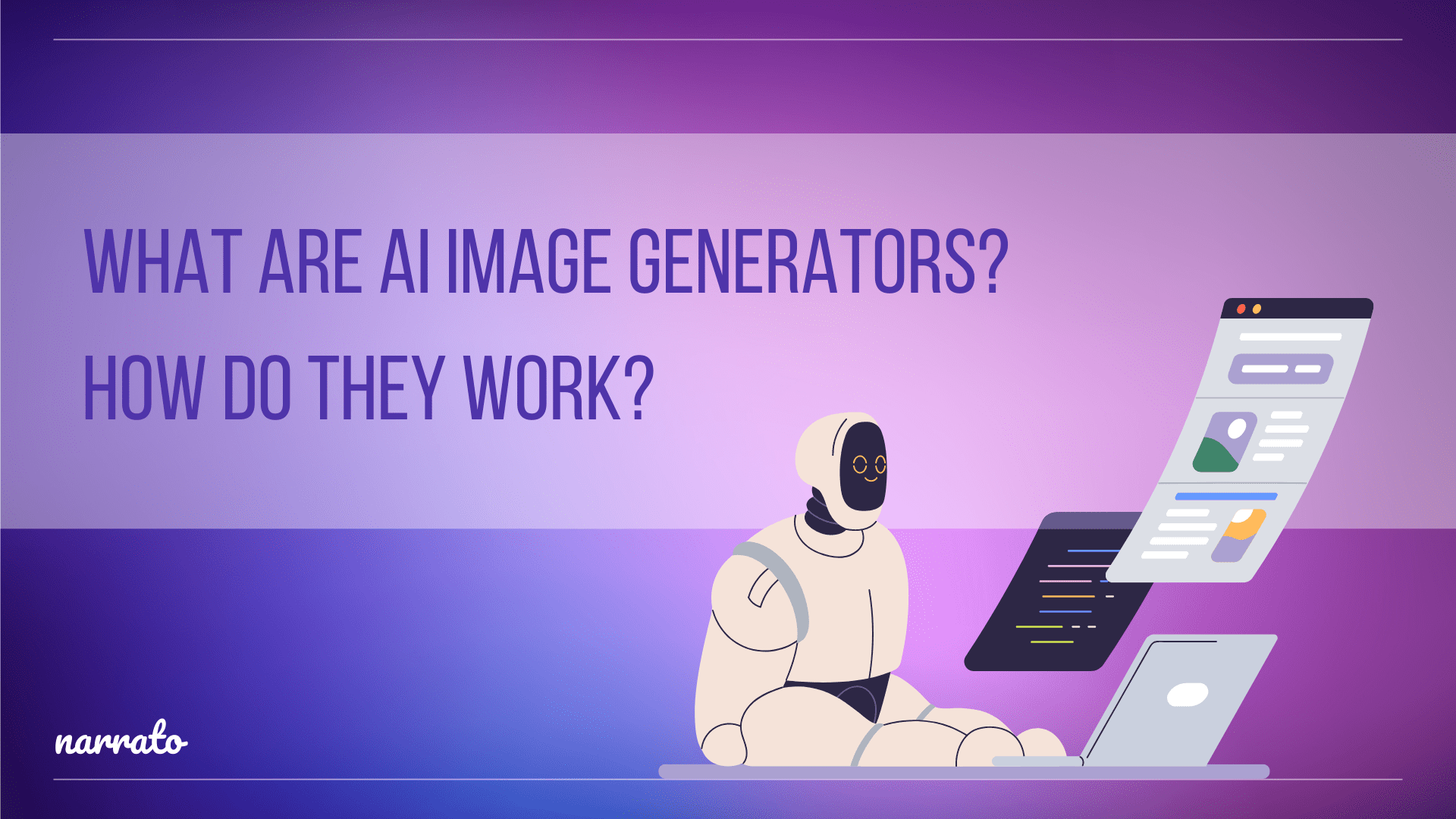Consumers today are no strangers to visual effects (VFX) and computer-generated imagery (CGI), the technology that has made it easier to create realistic images that increase the sense of immersion. It is because of these new-age tools that we’ve been able to enjoy some of our favorite movies, like Avatar and Jurassic Park. While these animation tools have been around for some time, a new technology is making huge waves in the content industry – AI Image Generators.
AI text-to-image generators are becoming increasingly popular as they offer a simpler way to generate images that are both visually appealing and relevant to the content. With Narrato’s AI image generator, you can get a visual representation of your ideas in a matter of seconds. In fact, this revolutionary technology has the power to completely transform the world of visual content creation!
So, are you interested in learning more about AI image generator tools and how they work? This blog post will cover it all.
What is an AI image generator?
How do AI image generators work?
Using AI image generators for content marketing
Using AI Image Generators: Tips and Best Practices
- Develop a general idea for the AI image
- Learn the nitty-gritty of prompt engineering
- Learn graphic design, photography, art jargon
- Repeat your prompt multiple times
- Experiment with the AI image generator settings
- Refine the images with post-processing tools
Benefits of using AI image generators

What is an AI image generator?
An AI image generator from text is exactly what you think it is. It is an AI-powered tool that takes a text prompt, processes it, and creates an image that best matches the description given in the text prompt. Don’t confuse them with AI image-sourcing tools though. AI photo generation is completely different from sourcing. While image-sourcing tools can be used to search and download existing images available on different platforms, an AI image generator creates entirely new images that do not exist in reality.
Narrato is an AI Content Workspace that offers both these capabilities. The AI Images tool allows you to create your own customized AI images with just a few words.
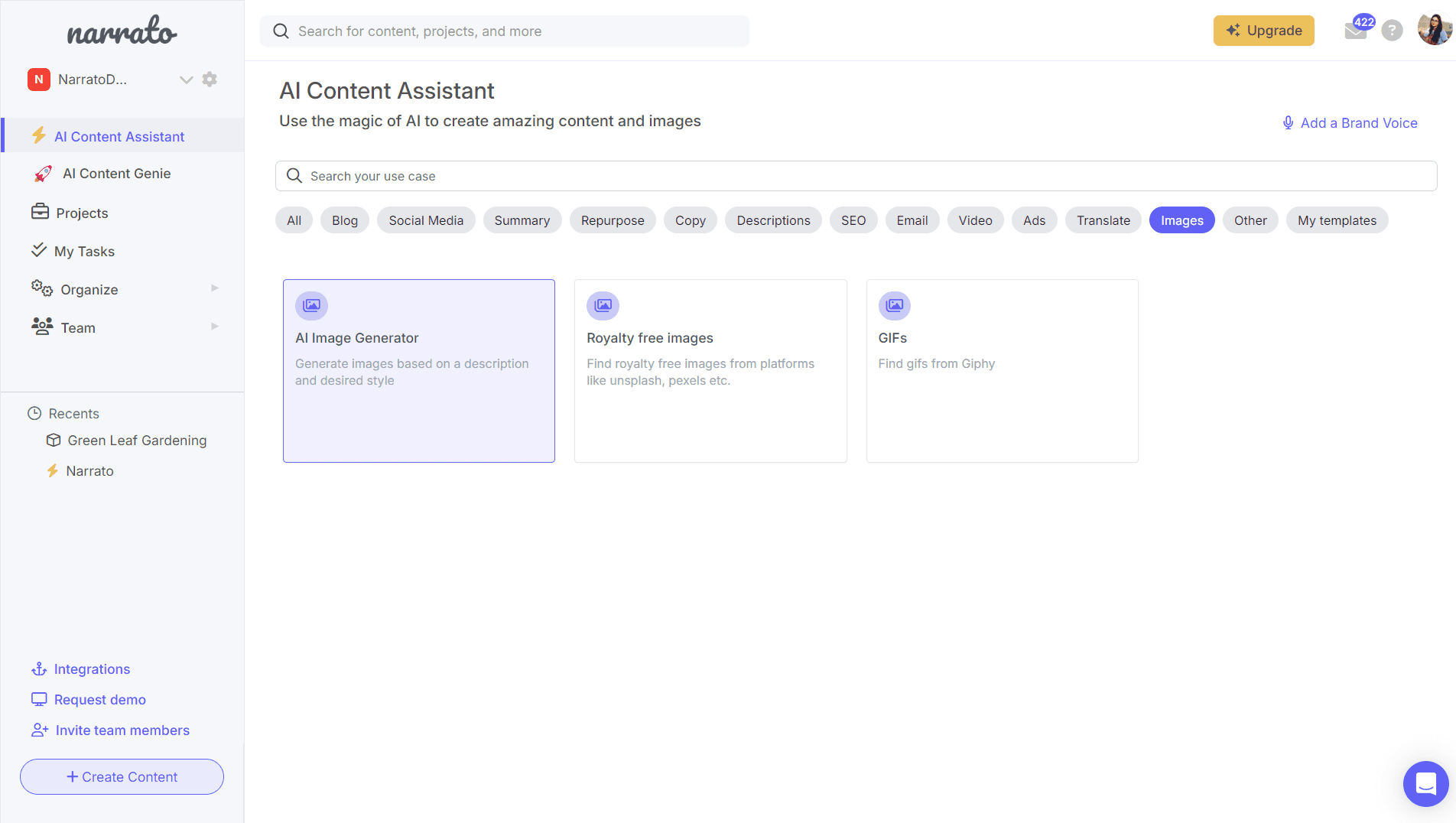
There is also the Free Image Search tool, which allows you to search for attribution-free stock images (sourced from Unsplash, Pexels, Pixabay, and Canva) to go with your content.

The idea of generating images from text using AI has been around for several decades. But the recent advancements in the field of text-to-image generation have made it possible to develop more sophisticated tools that are able to create high-quality images with different art styles. This has opened up a world of possibilities for anyone working with visual content. Your prompt could be anything, like “an apple-shaped chair in a sunlit lounge with a teddy bear sitting on it” to “a donkey in a spacesuit”. Here’s a sample generated using Narrato’s AI image tool.

With an AI picture generator, you can dream up whatever you’d like and bring it to life! Create images of animals, landscapes, characters, objects, 3D models, and more, and customize and personalize them with various details.
TL;DR Here’s a quick summary video on this article.
How do AI image generators work?
An AI image generator uses an advanced machine learning algorithm known as artificial neural networks (ANN) to generate new images. The ANN, which is modeled on biological neural networks, is trained on a large number of image-text pairs. It processes this information to learn everything, whether it’s Van Gogh’s paintings, the blue color, or what different objects look like. After learning the patterns and styles from the existing data, the AI image generator can interpret every text prompt to create new images mimicking any art form. And it does so in a matter of seconds. This means that the user can see the resulting AI image almost immediately.
Using AI image generators in content marketing
The world of content marketing, as it exists today, is radically different from what it was a few years ago. It’s not so much about quantity anymore, as it is about quality. And while content SEO and traffic generation are still important, the focus has shifted toward creating content that engages the audience and truly resonates with them.
Businesses have realized the need to accelerate content creation and content distribution. Small and medium businesses without a large content team that includes graphic designers or visual content creators must not fall behind though. This is where technology helps. SMBs now have a buddy they can turn to for assistance – AI tools for marketing and content creation. These tools also make it easy to incorporate inspiring business quotes into social posts and marketing content, helping brands connect emotionally with their audience.
Artificial Intelligence (AI) tools have revolutionized the world of content marketing by streamlining the content workflow and automating several processes. If you’re having trouble coming up with creative content topics, you can turn to AI content idea generators. If you need a writing assistant to help you with creative blocks, there are AI content writing tools. If you’re looking to optimize your content for SEO, you can create complete content briefs using an AI SEO content brief generator. With an AI image generator, your content creation tool stack is almost complete.
How can content marketers use AI image generators like Narrato?
Crafting engaging visual content is no easy task; it requires careful thought, attention to detail, besides some level of creative skills. A recent Venngage survey has found that the biggest challenge for 31.8% of marketers while creating visual content is producing it consistently. Coming up with great designs every time was also a major challenge for 19.6% of surveyed marketers.
Coming up with original images and graphics is not possible every time, and you can depend only so much on stock photos. AI-generated images can come to your rescue here. Using Narrato’s AI image generator as your creative sidekick, you can improve the efficiency of your visual content development process. This text-to-image generator essentially allows you to create 4 artificial intelligence pictures with a single prompt. And these are not just generic images. Narrato’s AI image generator gives you the option to choose the style of image, with options like –

There are also additional style options like –
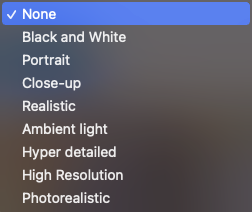
You can access the AI Images tool through the AI Content Assistant on the Narrato Workspace. It’s also available on the content task page, for ease of creating images while writing content. On most AI image generators, you can provide the tool with a prompt describing the image in detail through an intuitive graphical interface, making it easy to refine and adjust your inputs. On Narrato, you can add up to 1000 characters in the image description. After adding the prompt, just select the style of the image from the options available, and click generate. Et voila! Your AI image will be ready.

If the results don’t quite meet your expectations, don’t worry – you can always go back and give it another go. Try switching up the words or adding more detail to really get the image you’re looking for. Experiment with different combinations of text, prompts, and styles until you’re satisfied with the outcome. The custom AI image generated can then be added to your blog posts, website copy, social media content, or, anywhere else.
With the basics of AI image generators covered, let’s take a look at some tips for creating stellar AI-generated photos.

Using AI Image Generators: Tips and Best Practices
Creating truly remarkable AI images requires more than just plugging random words into the AI image generator and hoping for the best. If you want to create something truly special, here are some tips for using AI image generators –
1. Develop a general idea for the AI image
Before you can start experimenting with image description prompts, you need to have a general idea about the kind of AI image you’d like the tool to create. Decide on the subject matter for the image. What is the general feeling you want to evoke through it? What would the scene be like? Would there be any other objects in the frame? This will form the foundation of the AI image generation process.
Here’s an excellent tip – A reverse image search using Pinterest, Google Images, or web based image finder can help you develop a better understanding of what you should include. Examine the tags associated with the images to narrow down some words you can use for the prompt.
2. Learn the nitty-gritty of prompt engineering
The accuracy and quality of the AI-generated images depend a lot on how well you’re able to craft the image description prompt. If you know some basics of prompt engineering, creating stellar AI images will become easier. Here are some tips for writing a good prompt –
- Make sure your description contains a noun, a verb, and an adjective.
- Don’t limit yourself to one adjective. Using multiple adjectives will help create an AI image that accurately represents the intended concept.
- To provide better context, use at least 3 words. The upper limit depends on your tool. With Narrato’s AI image generator, you can add a maximum of 1000 characters.
- If you want the AI image to mimic the style of any popular artwork or cartoon, use “in the style of” in the prompt. Here is an example, where we asked the tool to create “a picture of a sunset in the style of The Simpsons”

- If you are looking to create artwork in a specific style, try to include the names of different art styles (contemporary, surrealism, minimalism, etc.) in the prompt.
- Mention the quality your want – high/medium/low/4k/8k. Here, we first asked the tool to generate a low-quality image of a sunset, and then a high-quality image of a sunset. You can clearly see the difference between the two.


- Specify the color palette for the image in your prompt. Prompt example: “Create an image of a work desk using the color palette yellow”. Here is the result –
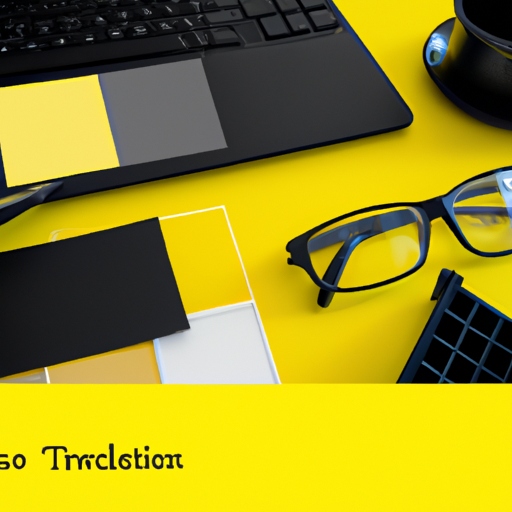
3. Learn graphic design, photography, art jargon
The key to creating better AI images is using the right words. And the best way to describe images can be found in the jargon used in graphic design, photography, and art. Exploring resources like Envato creative library can also help you familiarize yourself with these specific terms, enabling you to provide more accurate prompts to your AI image generator.
- Photography jargon keywords: Bokeh, exposure, white balance, contrast, saturation, vibrance, hue, tonal range, sharpness, grain/noise, vignetting, etc.
- Graphic design jargon keywords: Kerning, symmetry, asymmetry, texture, layout, white space, balance, proportion, etc.
- Art jargon keywords: Surrealism, Impressionism, Minimalism, Brushstroke, Impasto, Avant-garde, and more.
Pro Tip: If you want the AI art to mimic the work of an artist, you can include their name in the prompt. You can also include the name of multiple artists to merge the style of their artworks.
Here, we provided the prompt – “girl watching the sunrise on the beach, in the style of Van Gogh and Vermeer”. This is what it came up with –
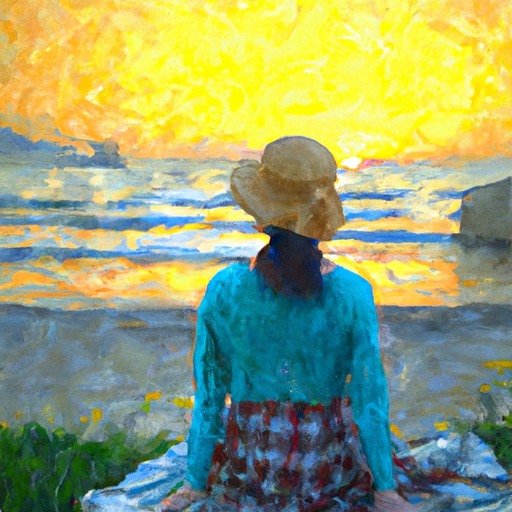
4. Repeat your prompt multiple times
When the same prompt is repeated to AI image generators, they are able to learn the associated concepts more accurately. So, if you’re not happy with the results on your first try, try again, and again and again. With repeated prompts, the AI image generator will be able to better understand what you want, especially if it’s an abstract concept.
Pro tip: While repeating the prompt in multiple AI image generation efforts will give better results, you can also achieve this by repeating certain words in the prompt. For instance, “a very very very beautiful night sky”.
5. Experiment with the AI image generator settings
Artificial Intelligence image generators provide a range of settings to customize the output. It is recommended to experiment with these settings to get the desired outcome. Tinkering with the settings will allow you to tailor the AI image output to better suit your needs. You can adjust parameters such as color, resolution, contrast, etc., in the prompt, and choose different styles to create AI images. Try different combinations to get the perfect image output for your content piece.
6. Refine the images with post-processing tools
After you’ve generated the images with an AI images tool, you can use post-processing tools like Adobe Photoshop, Luminar, and GIMP to enhance the quality of the images. Post-processing tools can help you fine-tune the AI images so that they look exactly the way you want them to. You can use these tools to adjust the colors, brightness, contrast, and other aspects of an AI image.
Benefits of using AI image generators
AI image generators offer numerous benefits to content creators, marketers and other creatives. With just a few clicks, you can produce images that appear to have been taken by a professional photographer.
For instance, Vidnoz AI Headshot Generator is one such AI tool that can transform your selfies into high-quality headshots without expensive photo shoots. Simply upload a few daily photos and Vidnoz’s AI algorithms work their magic, seamlessly blending your face onto a variety of professional backdrops and clothing options.
AI image generators can even create images of things that would never be found in reality. So the benefits are not only time-saving and cost-saving but also the ability to turn your wildest ideas into something tangible.
For example, if you’ve got an eCommerce website focused on men’s custom suits, you can generate AI images for your suits to showcase them on different models. You can then use these images on your store for a more professional look.
Here’s what you can get from using AI image generators –
- Higher productivity: You can create beautiful images and graphics without having to learn the complex art of editing. You wouldn’t have to browse through hundreds of stock photos either to find a perfect image.
- Unique images: Every single image created by an AI image generator is one of a kind. You can be sure that your visual content will be unique.
- Greater control over design: With an AI image generator, you’re not dependent on the existing set of design features offered by a graphic design tool. You can add as many details as you like, whether it’s adjusting the textures, lighting, color palette, or anything else.
- High-resolution AI images: AI text-to-image generators can help you create detailed, high-quality images. With Narrato’s AI image generator, for instance, you get a standard resolution of 512×512 pixels, making it great for any content project.
Wrapping Up
AI image generators like Narrato can be a great addition to a content marketer’s toolkit. By just familiarizing yourself with the best practices for using AI image generators, you can create stunning visuals that will help your content stand out from the competition. And with more and more people utilizing this technology, it’s safe to assume that it will continue to evolve and become even more effective. So, why not give it a try? Try experimenting with an AI image generator yourself, and tell us what techniques worked best for you.


